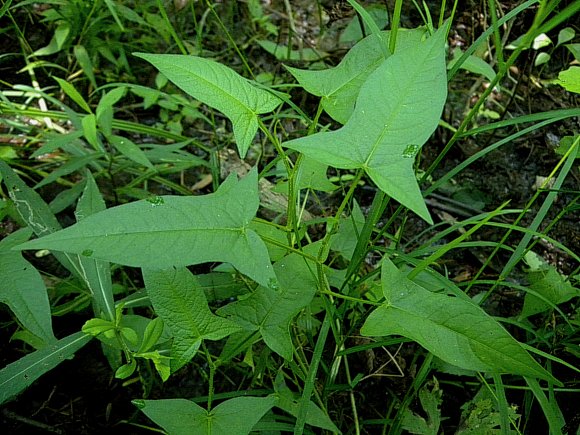
Both axillary and terminal inflorescences are produced on peduncles about 1-4" long. These inflorescences are variable, consisting of dense head-like racemes, interrupted racemes that are sparsely flowered, and/or sparsely branched panicles consisting of 2 or more racemes. Sometimes only a single flower is produced, rather than a raceme of flowers. Each flower is about ¼" (5-6 mm.) long, consisting of 4-5 tepals, an ovary with a pair of styles, and 6 stamens (less often 8 stamens). The tepals can be reddish white, pinkish white, greenish white, or white; they are broadly elliptic in shape. The peduncles are light green, glandular-hairy, and sometimes prickly below. The blooming period occurs from mid-summer into the fall, lasting about 1-3 months. Afterwards, the flowers are replaced by seeds that are 3.5-4.0 mm. long and a little less across at maturity; they are ovoid, slightly flattened, biconvex (rounded on both sides), dark brown, and shiny. This vine can spread vegetatively by forming rootlets when the nodes of stems touch moist ground.
Cultivation: This vine prefers partial sun, wet to consistently moist conditions, and soil containing some sand and decaying organic matter (silt and other soil types may also be acceptable). Most growth and development occurs during the summer.

Range & Habitat: Halberd-Leaved Tearthumb is native to only a few counties in the eastern half of Illinois (see Distribution Map). It is state-listed as 'endangered.' This vine is probably extirpated from Macon and McHenry counties because their specimens were collected prior to 1875 (Mohlenbrock, 2002). Illinois lies along the western-range limit of this species; it is more common further to the east. Habitats include bottomland woodlands, swamps, seeps and springs, low areas along ponds, and sloughs with fairly consistent moisture levels. Many of the preceding habitats, where this vine occurs, are often sandy and partly shady. Halberd-Leaved Tearthumb is usually found in high quality natural areas.
Faunal Associations: Little is known about the floral-faunal relationships of this vine specifically, although they are probably similar to those of smartweeds (Persicaria spp.). The flowers are probably pollinated by small bees, various flies, small butterflies, and wasps. Insects that feed on various parts of smartweeds include the caterpillars of butterflies and moths, flea beetles, aphids, and stink bugs. In particular, caterpillars of the butterflies Lycaena helloides (Purplish Copper) and Lycaena hyllus (Bronze Copper) feed on the foliage of smartweeds. Such wetland birds as the Mallard and other dabbling ducks, some rails, and granivorous songbirds (e.g., Bobolink, Swamp Sparrow, Redwing Blackbird) eat the seeds. Because Halberd-Leaved Tearthumb can form a tangle of leaves and prickly stems, it is able to provide some protective cover to various kinds of wetland wildlife.

Photographic Location: An open sandy swamp at the Indiana Dunes State Park in NW Indiana.
Comments: Halberd-Leaved Tearthumb can be distinguished from other similar vines in Illinois by its prickly stems and hastate leaves (shaped like Medieval halberds). Its closest relative in the state, the more common Tracaulon sagittatum (Arrow-Leaved Tearthumb), differs by having sagittate leaves (shaped like arrowheads), ochrea that lack rings of prickles, and seeds that are bluntly 3-angled (rather than biconvex and two-sided). Many contemporary authorities prefer to merge Tearthumb vines (Tracaulon spp.) with the smartweeds (Persicaria spp.). As a result, they refer to Halberd-Leaved Tearthumb as Persicaria arifolia. Another scientific name for this species, Polygonum arifolium, also appears in older sources of information. The classification that is used here follows Mohlenbrock (2002) and Mohlenbrock (2010). The leaves of Halberd-Leaved Tearthumb superficially resemble the leaves of other species, both wild and cultivated, in the Arum family (Araceae). This similarity of form is the source of the scientific name for this species (arifolium).